Remove the delivery pipe (A).

Engine removal is required for this procedure.
To avoid damaging the cylinder head, wait until the engine coolant temperature drops below normal temperature before removing it.
When handling a metal gasket, take care not to fold the gasket or damage the contact surface of the gasket.
Turn the crankshaft pulley so that the No. 1 piston is at top dead center.
Remove the engine assembly. (Refer to engine and transaxle in this gruop)
Remove the timing chain. (Refer to Timing chain in this group)
Remove the intake and exhaust manifold. (Refer to Intake and exhaust system in this group)
Remove the delivery pipe (A).

Remove the glow plug (A).

Disconnect the water hose (A) from thermostat housing.
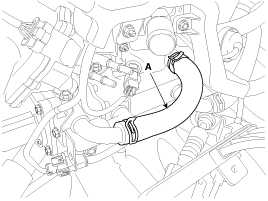
Remove the thermostat housing (A).

Remove the vacuum pump (A).
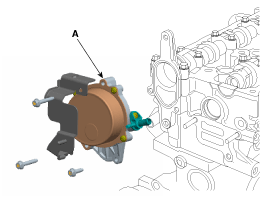
Do not disassemble the vacuum pump.
Remove the camshaft bearing caps (A).
Mark the camshaft bearing caps to be able to reassemble in the original position and direction.
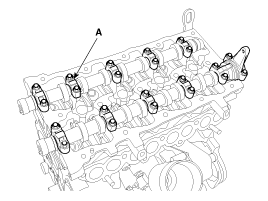
Remove the camshaft (A).
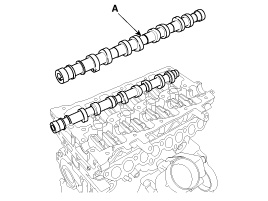
Remove the cam follower (A).

Remove the HLA(Hydraulic Lash Adjust).
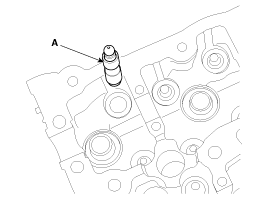
Remove the cylinder head bolts, then remove the cylinder head.
Using bit socket (12PT), uniformly loosen and remove the 10 cylinder head bolts, in several passes, in the sequence shown.Remove the 10 cylinder head bolts.
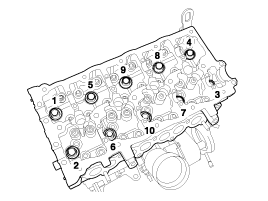
Head warpage or cracking could result from removing bolts in an incorrect order.
Lift the cylinder head (A) from the dowels on the cylinder block and replace the cylinder head on wooden blocks on a bench.
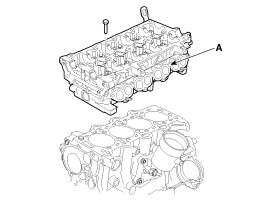
Be careful not to damage the contact surfaces of the cylinder head and cylinder block.
Remove the valves.
Using the SST (09222-3K000, 09222-2A100), compress the valve spring and remove the retainer lock.
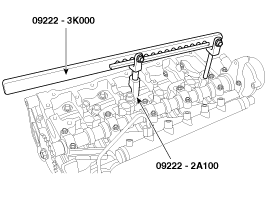
Remove the spring retainer.
Remove the valve spring.
Remove the valve.
Using a needle-nose pliers, remove the stem oil seal.
Inspect for flatness.
Using a precision straight edge and feeler gauge, measure the surface the contacting the cylinder block and the manifolds for warpage.
Flatness of cylinder head gasket surface :
Less than 0.05mm (0.0020in) for all
Less than 0.03mm (0.0012in) for each cylinder
Less than 0.012mm (0.00047in) for 50mm (1.9685in.) x 50mm (1.9685in.)
Flatness of manifold mating surface :
Less than 0.025mm (0.0010in) for width
Less than 0.160mm (0.0063in) for length
Less than 0.013mm (0.00051in) for 50mm (1.9685in.) x 50mm (1.9685in.)

Inspect for cracks.
Check the intake ports, exhaust ports and cylinder block surface for cracks. If cracked, replace the cylinder head.
Inspect the valve stems and valve guides.
Using a caliper gauge, measure the inner diameter of valve guide.
Valve guide inner diameter :
Intake : 5.500 ~ 5.512mm (0.2165 ~ 0.2170in)
Exhaust : 5.500 ~ 5.512mm (0.2165 ~ 0.2170in)

Using a micrometer, measure the outer diameter of valve stem.
Valve stem outer diameter
Intake : 5.455 ~ 5.470mm (0.2148 ~ 0.2154in)
Exhaust : 5.435 ~ 5.450mm (0.2140 ~ 0.2146in)
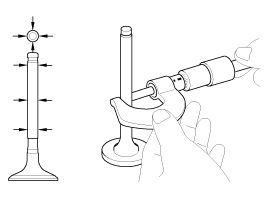
Subtract the valve stem outer diameter measurement from the valve guide inner diameter measurement.
Valve stem- to-guide clearance
Intake : 0.030 ~ 0.057mm (0.0012 ~ 0.0022in)
Exhaust : 0.050 ~ 0.077mm (0.0020 ~ 0.0030in)
If the clearance is greater than specification, replace the valve and valve guide.
Inspect the valves.
Check the valve is ground to the correct valve face angle.
Check that the surface of valve for wear.
If the valve face is worn, replace the valve.
Check the valve head margin thickness. If the margin thickness is less than specification, replace the valve.
Margin
Intake : 1.1mm (0.0433in)
Exhaust : 1.2mm (0.0472in)
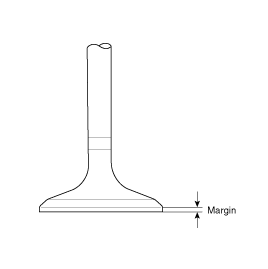
Check the valve length.
Length
Intake : 93.0mm (3.6614in)
Exhaust : 93.7mm (3.6890in)
Check the surface of valve stem tip for wear.
If the valve stem tip is worn, replace the valve.
Inspect the valve seats.
Check the valve seat for evidence of overheating and improper contact with the valve face. If the valve seat is worn, replace the cylinder head.
Check the valve guide for wear. If the valve guide is worn, replace the cylinder head.
Inspect the valve springs.
Using a steel square, measure the out-of-square of valve spring.
Using a vernier calipers, measure the free length of valve spring.
Valve spring
Standard
Free height : 44.9mm (1.7677in)
Load : 17.5±0.9kg/32.0mm (38.6±2.0lb/1.2598in)
31.0±1.6kg/23.5mm (68.3±3.5lb/0.9252in)
Out of square : Less than 1.5°
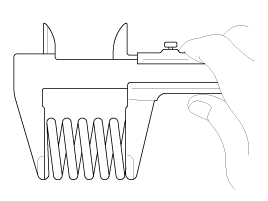
If the loads is not as specified, replace the valve spring.
Inspect the cam lobes.
Using a micrometer, measure the cam lobe height.
Cam height
LH camshaft
Intake : 35.452 ~ 35.652mm (1.3957 ~ 1.4306in)
Exhaust : 35.700 ~ 35.900mm (1.4055 ~ 1.4134in)
RH camshaft
Intake : 35.537 ~ 35.737mm (1.3991 ~ 1.4070in)
Exhaust : 35.452 ~ 35.652mm (1.3957 ~ 1.4036in)
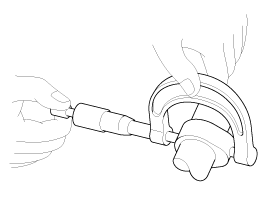
If the cam lobe height is less than specification, replace the camshaft.
Inspect the camshaft journal clearance.
Clean the bearing caps and camshaft journals.
Place the camshafts on the cylinder head.
Lay a strip of plastigage across each of the camshaft journal.

Install the bearing caps and tighten the bolts with specified torque.
Tightening torque :
12.7 ~ 14.7N.m (1.3 ~ 1.5kgf.m, 9.4 ~ 10.8lb-ft)
Do not turn the camshaft.
Remove the bearing caps.
Measure the plastigage at its widest point.
Bearing oil clearance
0.040 ~ 0.077mm (0.0016 ~ 0.0030in)

If the oil clearance is greater than specificaiton, replace the camshaft. If necessary, replace the bearing caps and cylinder head as a set.
Completely remove the plastigage.
Remove the camshafts.
Inspect the camshaft end play.
Install the camshafts.
Using a dial indicator, measure the end play while moving the camshaft back and forth.
Camshaft end play
Standard : 0.1 ~ 0.2mm (0.0039 ~ 0.0079in)
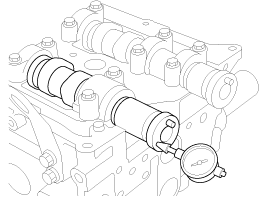
If the end play is greater than specification, replace the camshaft. If necessary, replace the bearing caps and cylinder head as a set.
Remove the camshafts.
With the HLA filled with engine oil, hold A and press B by hand.
If B moves, replace the HLA.

Problem | Possible cause | Action |
1. Temporary noise when starting a cold engine | Normal | This noise will disappear after the oil in the engine reaches the normal pressure. |
2. Continuous noise when the engine is started after parking more than 48 hours. | Oil leakage of the high pressure chamber on the HLA, allowing air to get in. | Noise will disappear within 15 minutes when engine runs at 2000-3000 rpm. If it doesn’t disappear, refer to step 7 below. |
3. Continuous noise when the engine is first started after rebuilding cylinder head. | Insufficient oil in cylinder head oil gallery. | |
4. Continuous noise when the engine is started after excessively cranking the engine by the starter motor or band. | Oil leakage of the high-pressure chamber in the HLA, allowing air to get in. Insufficient oil in the HLA. | |
5. Continuous noise when the engine is running after changing the HLA. | caution Do not run engine at a speed higher than 3000 rpm, as this may damage the HLA. | |
6. Continuous noise during idle after high engine speed. | Engine oil level too high or too low. | Check oil level. Drain or add oil as necessary. |
Excessive amount of air in the oil at high engine speed. | Check oil supply system. | |
Deteriorated oil. | Check oil quality. If deteriorated, replace with specified type. | |
7. Noise continues for more than 15 minutes. | Low oil pressure. | Check oil pressure and oil supply system of each part of engine. |
Faulty HLA. | Remove the cylinder head cover and press HLA down by hand. If it moves, replace the HLA. |
Thoroughly clean all parts to be assembled.
Before installing the parts, apply fresh engine oil to all sliding and rotating surface.
Replace oil seals with new ones.
Install the valves.
Using the SST (09222-2A000) (A), push in a new stem oil seal.
Do not reuse old valve stem oil seals.
Incorrect installation of the seal could result in oil leakage past the valve guides.
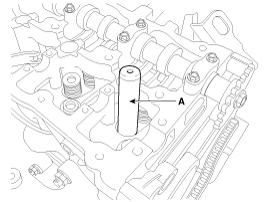
Install the valve, valve spring and spring retainer.
Place the valve springs so that the side coated with enamel faces toward the valve spring retainer and then installs the retainer.
Using the SST (09222-2A100, 09222-3K000), compress the spring and install the retainer locks.
After installing the valves, ensure that the retainer locks are correctly in place before releasing the valve spring compressor.

Lightly tap the end of each valve stem two or three times with the wooden handle of a hammer to ensure proper seating of the valve and retainer lock.
Thoroughly clean all parts to be assembled.
Always use a new cylinder head and manifold gasket.
Always use a new cylinder head bolt.
The cylinder head gasket is a metal gasket. Take care not to bend it.
Rotate the crankshaft, set the No.1 piston at TDC.
Cylinder head dowel pins must be aligned.
Select the cylinder head gasket.
Measure the piston protrusion from the upper cylinder block face (I) on 8 places (A ~ H) at T.D.C.
Measure on the crankshaft center line considering the piston migration.
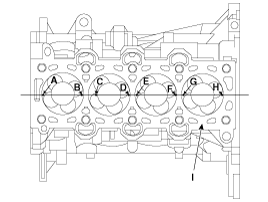

Select the gasket in the table below using the average value of piston protrusions. Although even the only 1 point is over than the each rank limit, use 1 rank upper gasket than specified in the table below.
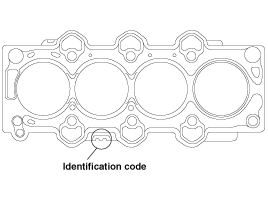
Displacement | 1.7 | ||
Average of piston protrusion | 0.035 ~ 0.105mm (0.0014 ~ 0.0041in) | 0.105 ~ 0.175mm (0.0041 ~ 0.0069in) | 0.175 ~ 0.245mm (0.0069 ~ 0.0096in) |
Gasket thickness | 1.00 ~ 1.15mm (0.0394 ~ 0.0453in) | 1.05 ~ 1.20mm (0.0413 ~ 0.0472in) | 1.10 ~ 1.25mm (0.0433 ~ 0.0492in) |
Limit of each rank extent | 0.14mm (0.0055in) | 0.21mm (0.0083in) | - |
Identification code |  |  |  |
Gasket grade | A | B | C |
Install the gasket so that the identification mark faces toward the timing chain side.
Install the cylinder head gasket (A) on the cylinder block.
Be careful of the installation direction.
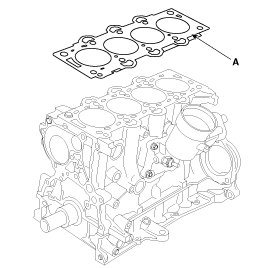
Place the cylinder head (A) quietly in order not to damage the gasket with the bottom part of the end.

Install the cylinder head bolts.
Do not apply engine oil on the cylinder head bolts.
Using the SST (09221-4A000), install and tighten the 10 cylinder head bolts, in several passes, in the sequence shown.
Tightening torque :
47.1~51.0Nm (4.8~5.2kgf.m, 34.7~37.6lb-ft) + (88~92°) + (118~122°)
Do not reuse the cylinder head bolts.

Istall the HLA (Hydraulic Lash Adjust) (A).

Until installing HLA shall be held upright so that diesel oil in HLA should not spill and assured that dust does not adhere to HLA.
HLA shall be inserted tenderly to the cylinder head not to spill diesel oil from HLA. In case of spilling, air bent shall be done in accordance with the air bent procedure.
Stroke HLA in diesel oil 4~5 times by pushing its cap while pushing the ball down slightly by hard steel wire. (Take care not to severely push hard steel wire down since ball is several grames.)
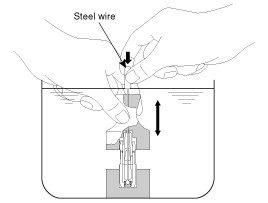
Install the cam follower (A).

Install the camshaft (A).

Install the camshaft bearing caps (A).
Tightening torque :
12.7 ~ 14.7N.m (1.3 ~ 1.5kgf.m, 9.4 ~ 10.8lb-ft)

Install the vacuum pump (A) with new gasket (B).
Tightening torque :
10.8 ~ 14.7N.m (1.1 ~ 1.5kgf.m, 8.0 ~ 10.8lb-ft)
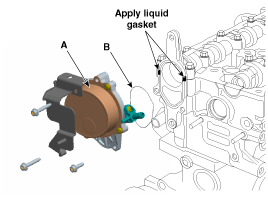
Apply engine oil to the O-ring(A) of vacuum pump shaft before assembling vacuum pump.
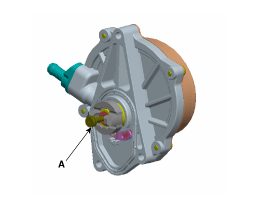
Install the thermostat housing (A).
Tightening torque :
9.8 ~ 11.8N.m (1.0 ~ 1.2kgf.m, 7.2 ~ 8.7lb-ft)

Reconnect the water hose (A) to thermostat housing.

Install the glow plug (A) and glow plug plate.
Tightening torque :
Glow plug : 14.7 ~ 19.6N.m (1.5 ~ 2.0kgf.m, 10.8 ~ 14.5lb-ft)
Plate nut : 0.8~1.5N.m (0.08 ~ 0.15kgf.m, 0.6 ~ 1.1lb-ft)

Install the common rail (A).
Tightening torque :
14.7 ~ 21.6N.m (1.5 ~ 2.2kgf.m, 10.8 ~ 15.9lb-ft)

Install the intake and exhaust manifold. (Refer to Intake and exhaust system in this group)
Install the timing chain. (Refer to Timing chain in this group)
Install the engine assembly to the vehicle. (Refer to Engine and transaxle assembly in this group)